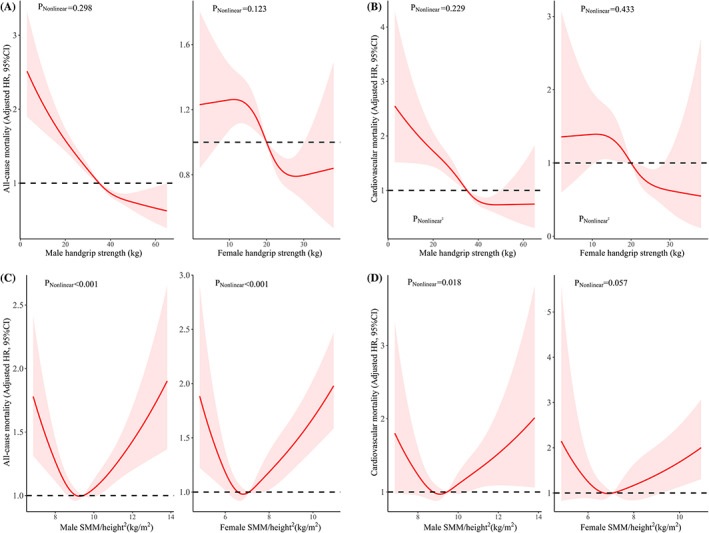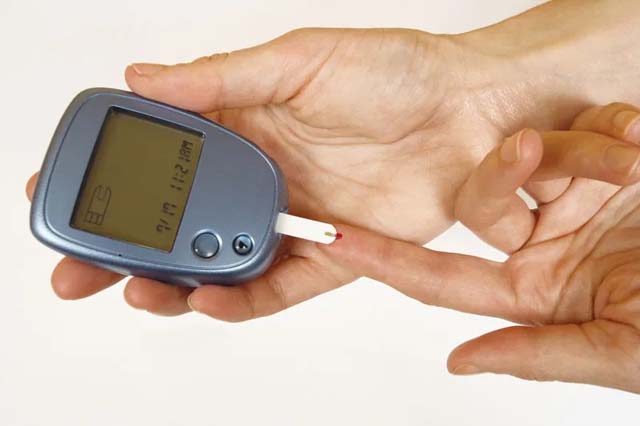Highlights • The prevalence of low handgrip strength and skeletal muscle mass was higher in women and in patients with long-term diabetes and increased with age and decreasing body mass index. • All-cause mortality and cardiovascular mortality risk showed a decreasing linear trend with increasing handgrip strength, while skeletal muscle mass showed a nonlinear U-shaped relationship with all-cause mortality. causes and risk of cardiovascular mortality. • Low handgrip strength was a better predictor of all-cause mortality and cardiovascular mortality risk than low skeletal muscle mass. |
Associations between handgrip strength and skeletal muscle mass with all-cause mortality and cardiovascular mortality in people with type 2 diabetes: a UK Biobank prospective cohort study
Sarcopenia is a geriatric syndrome with age-related loss of muscle mass, decreased muscle strength, and/or decreased somatic function . In recent years, sarcopenia has received increasing attention. Several previous studies have shown that sarcopenia is strongly associated with a wide range of adverse health outcomes, including fractures, falls, frailty, hospitalization, physical disability, cardiovascular diseases (CVD), and even mortality. It not only seriously reduces the quality of life of patients, but also imposes a high economic burden on individuals and society. Previous studies have shown that sarcopenia can significantly increase the risk of mortality in the general population, particularly in older subjects.
As one of the three most common chronic diseases worldwide, patients with type 2 diabetes typically show a progressive decline in both muscle mass and strength. The effects of sarcopenia in older patients with type 2 diabetes are of increasing concern, especially given the aging of the world’s population. Studies have shown that patients with diabetes are at increased risk of sarcopenia and have significantly lower muscle mass and strength compared to the general population. Additionally, patients with diabetes have a higher risk of all-cause and CVD mortality compared to the general population.
In the present study, we used data from the UK Biobank, a large prospective population-based cohort, to investigate the strength and pattern of associations between sarcopenia, muscle strength and muscle mass with the risk of mortality from all causes and by CVD in a diabetic population.
Goals
To explore the associations between handgrip strength (HGS) and skeletal muscle mass (SMM) with the risk of all-cause and cardiovascular disease (CVD) mortality in patients with type 2 diabetes (T2DM).
Materials and methods
Data were obtained from the UK Biobank. The baseline survey was conducted between 2006 and 2010 and was followed for a median of 12.52 years. Handgrip strength ( HGS) was measured using a dynamometer and skeletal muscle mass (SMM) was measured using the bioelectrical impedance method. Mortality was available through links to the National Health Service Information Centre. Sex-specific analyzes were performed.
Results
A total of 13,392 participants with DM2 were included, with a mean age of 60.39 years and 52.35% men. During follow-up, there were 3,006 (22.45%) deaths, including 746 (5.57%) CVD deaths.
The risk of all-cause mortality and CVD mortality among men and women increased progressively with decreasing HGS quartiles (p trend <0.05). A 1 SD decrease in HGS was found to increase the risk of all-cause (HR: 1.31 [95% CI: 1.24–1.38]) and the risk of CVD mortality (HR: 1.31 [95% CI: 1.24–1.38]). 35 [95% CI: 1.22–1.50]) for men and all-cause risk (HR: 1.26 [95% CI: 1.11–1.42]) and mortality risk by CVD (HR: 1.43 [95% CI: 1.09–1.89]) for women.
There was no statistically significant trend association between SMM/height 2 and mortality risk, and restricted cubic regression splines indicated that SMM/height 2 showed a U-shaped nonlinear relationship (nonlinear p < 0.05). .

Figure: Adjusted hazard ratios (HR) for mortality using restricted cubic splines. (A) Handgrip strength and all-cause mortality. (B) Handgrip strength and cardiovascular mortality. (C) Skeletal muscle mass (SMM) and all-cause mortality. (D) Skeletal muscle mass and cardiovascular mortality. CI: confidence interval.
Conclusions In conclusion, we found that low grip strength appeared to be a better predictor of all-cause mortality and CVD mortality risk in patients with type 2 diabetes compared with low muscle mass. Grip strength showed a linear downward trend with mortality risk, while muscle mass showed a U-shaped relationship, and too low or too high muscle mass was associated with a higher risk of all-cause mortality and by CVD. Screening and diagnosis of sarcopenia in the diabetic population appears necessary, and attention should be focused on the occurrence of low levels of handgrip strength (HGS). |
















